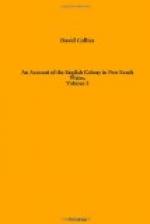The peculiar conformation of the amphibious animal mentioned on page 45 of this Volume*, having attracted the attention of Everard Home, esq a paper, containing the result of a minute examination of the external and internal parts of two specimens which had been preserved in spirits, and sent from Port Jackson to Sir Joseph Banks was drawn up by Mr. Home, and, having been read before the Royal Society (on Thursday the 17th December 1801), was afterwards published in the Philosophical Transactions. From that paper, which was most obligingly and politely sent to me by Mr. Home, I have, through the liberality of the President of that learned body, been allowed to select such particulars of this curious animal, as will, I think, be acceptable to the readers of this work; who no doubt will join with me in rejoicing that an animal, hitherto unknown to science, should have fallen under the observation and examination of a gentleman so eminently qualified to develop the secrets of nature.
[* viz: “Although the settlement had now been established within a month of ten years, yet little had been added to the stock of natural history which had been acquired in the first year or two of its infancy. The Kangaroo, the Dog, the Opossum, the Flying Squirrel, the Kangaroo Rat, a spotted Rat, the common Rat, and the large Fox-bat (if entitled to a place in this society), made up the whole catalogue of animals that were known at this time, with the exception which must now be made of an amphibious animal, of the mole species, one of which had been lately found on the banks of a lake near the Hawkesbury. In size it was considerably larger than the land mole. The eyes were very small. The fore legs, which were shorter than the hind, were observed, at the feet, to be provided with four claws, and a membrane, or web, that spread considerably beyond them, while the feet of the hind legs were furnished, not only with this membrane or web, but with four long and sharp claws, that projected as much beyond the web, as the web projected beyond the claws of the fore feet. The tail of this animal was thick, short, and very fat; but the most extraordinary circumstance observed in its structure was, its having, instead of the mouth of an animal, the upper and lower mandibles of a duck. By these it was enabled to supply itself with food, like that bird, in muddy places, or on the banks of the lakes, in which its webbed feet enabled it to swim; while on shore its long and sharp claws were employed in burrowing; nature thus providing for it in its double or amphibious character. These little animals had been frequently noticed rising to the surface of the water, and blowing like the turtle.”]
The natural history of this animal, which has obtained the name of Ornithorhynchus paradoxus is at present very little known. The following particulars were communicated to Mr. Home by Governor Hunter, who, during his residence in New South Wales, had opportunities of seeing the animal alive.




